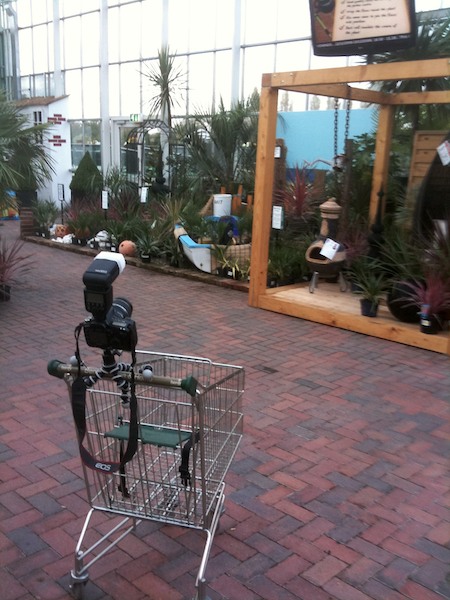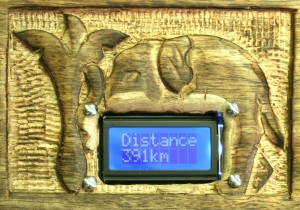
I love this gallery of images by Vincent Bousserez on the Telegraph website.

I love this gallery of images by Vincent Bousserez on the Telegraph website.
…everything looks like a tripod!

Those of my readers who are outside the UK will have been spared the whole ‘Question Time’ thing: the national debate about whether the head of the British National Party – the nearest thing Britain gets to far-right politics – should have been allowed to appear on the BBC’s Question Time debating programme.
He did appear, looked like rather a buffoon, and so today the papers are saying that he was so ridiculed that the BNP will do well out of it. Why? Because it looks as if the Beeb recklessly allowed him to be so overwhelmed that they made him into a martyr. The Beeb really can’t win on this one. Actually, of course, that’s not the reason the papers are printing this. They’re simply printing it because ‘BNP backlash’ makes a more profitable headline than some of the other possible speculations.
Anyway, since I don’t really do politics, and I don’t really watch TV, I might have remained blissfully ignorant of the whole thing if it weren’t for Twitter. Relaxing in the bath of a remote northern hotel room, I checked up on what my friends were tweeting about. (What? You don’t read Twitter in the bathroom? I thought that’s what it was for!) A lot of them were mentioning #bbcqt, and since I hadn’t come across Question Time before it took me a while to work out what this acronym meant. It was a bit like overhearing snatches of conversations in a café without knowing the topic of discussion.
Eventually I worked it out, and realised that it was probably big enough that I should try and watch some of it. It reminded me of my schooldays, when there were only three or four TV channels, so the chances of your schoolfriends having watched the same thing as you were really quite high, and it would be the topic of conversation the following day. Then, we knew what our friends were viewing because we had little choice. Now, we know because of social networks…
So, after towelling myself dry, I sat on the bed and spent a while seeing if my iPhone’s 3G connection was good enough that I could pull up the programme on iPlayer or some similar site. I was a little way into this when it hit me. Right in front of me was a TV set! It’s something I now ignore so totally when going into a hotel room that I hadn’t even noticed it was there!
I turned it on and, though the picture wasn’t as good as I would have got from iPlayer, I was able to watch the latter part of the programme that all my friends were watching… a somewhat fuzzy version but quite watchable after I had tweaked the little internal aerial a bit. It was just like the old days.
Except, I guess, for the tweeting-in-the-bath bit.
 Tonight, in the UK at least, we perform that ridiculous ritual of ‘putting the clocks back’. How much longer must we put up with this, for heaven’s sake? For once, though, I’m grateful, since Rose is catching a distressingly early flight in the morning, and the hour of our rising will at least feel less abominable than it would otherwise.
Tonight, in the UK at least, we perform that ridiculous ritual of ‘putting the clocks back’. How much longer must we put up with this, for heaven’s sake? For once, though, I’m grateful, since Rose is catching a distressingly early flight in the morning, and the hour of our rising will at least feel less abominable than it would otherwise.
It leaves me with a problem, though: what to use as an alarm clock?
Some of my gadgets are clever enough to take note of the time change automatically, others aren’t, and some (like my RDS clock radio) will pick up the change once they’re turned on. I’m really not sure whether they’ll do the right thing if I set an alarm tonight for a time in a different timezone tomorrow. So which of these should I take to whichever faceless Heathrow hotel is to be blessed with our patronage tonight?
I certainly don’t want to have any fewer hours of sleep than I’ll be getting already, but I also don’t want to gamble with getting to a transatlantic flight on time. So, ironically, I may take the most basic, least high-tech alarm clock which I know won’t try to do anything clever and I can then work out the time changes myself…
Both Google and Bing have signed agreements with Twitter to be able to index the live feed of ‘tweets’. There are several things I’d love to know about this.
Firstly, just from technical curiosity: how fast is that data flow, exactly? I wonder what kind of infrastructure is needed to index it in real time. Presumably they’re going to index everything?
Secondly, the business side… Several companies have exited successfully by creating something interesting enough for Google or Microsoft to want to buy. I wonder how many healthy ongoing businesses can be made from creating a data stream interesting enough for them to want to index?
And thirdly, the statistics will be fascinating, if we ever get to hear them. For example, I wonder how often the search query will now be longer than the item returned…
 Here’s a wonderful hardware project, very nicely written up by Mikal Hart.
Here’s a wonderful hardware project, very nicely written up by Mikal Hart.
Thanks to Stephen Turner for the link.
Once upon a time, only the rich could afford to buy books.
Now, only the rich can afford the time to read them.
I’m very impressed at what the Cambridge University Office of Communication have been up to recently. There’s a wonderful selection of stuff on iTunes U (which is now easy to access directly on an iPhone or iPod Touch).
But I’ve also just discovered the Cambridge University YouTube Channel which also has much of the same material in a different layout. The quality is excellent.
There are some lovely shorts produced by Windfall Films, too, in the Cambridge Ideas playlist. Here’s six minutes of my pal David Mackay:
I worry about the future. In particular I worry, as so many of us must, about whether the progress in desserts that has been achieved over the last few millennia will slow down in the centuries to come.
There are probably those who believe that puddings were all created long ago in a dramatic few days’ work, and collected together in Mrs Beeton’s ark, and have been fairly static ever since. Indeed, if one considers a beautiful specimen of Sticky Toffee Pudding, it is hard to believe that there wasn’t one, single infallible designer somewhere near the Garden of Cartmel who came up with the perfect dessert in one glorious act of creation.
But in truth the evidence for culinary evolution is all around us. I remember, when the family were invited to friends’ houses in my childhood, my mother would often ask for the recipe of any particularly delicious courses, and she in turn would pass the recipe on to others when requested. Sometimes, variations would be introduced by, say, an expected local shortage of brown sugar requiring a substitute to be found. If that mutation proved particularly successful, it would increase its likelihood of being replicated both in our own puddings, and of the recipe being transmitted more widely elsewhere. See? All the Darwinian… umm, ingredients… are there!
Now, I’m sure this process still occurs amongst those who have more frequent culinary intercourse than I do, but I wonder if the wide availability of standard recipes, of mass-media to transmit them, and the rarity of brown sugar shortages in this time of plentiful supply, means that the process of culinary evolution has slowed. On the other hand, it could be argued that, while mutations may be less frequent, the adoption of successful ones can now be much swifter.
Anyway, this is particularly exciting for me, because I’ve occasionally contemplated a return to academia, and have wondered about finding a topic of research that could truly capture my heart. Now, though, I intend to start submitting grant applications for a major project to trace the evolution of desserts, do extensive studies of the true qualities of various historical recipes around the globe, and explore whether such factors as online social networks can be harnessed to keep up the pace of culinary progress so that future generations have something to look forward to.
It would, of course, be tragic to make such research so theoretical that it was of little use beyond the ivory towers, so my proposal will be for a very ‘applied’ approach, involving extensive user testing…
In the beginning there was nothing. God said “Let there be light.” Now there was nothing, but you could see it better.
Seen on Twitter – thanks to @weirdralph
Now, here’s an interesting challenge: can you re-learn one of your earliest-developed skills in a different way? When you get to my age, those neural pathways are pretty fossilised… but if you want the challenge, to keep your brain supple, why not try a new way of tying your shoelaces?
The Ian Knot gives you the same results as the conventional shoelace-tying method, but faster and more evenly. Something to practise in front of the hearth on those long winter’s nights? Here’s how to do it, and here’s an alternative set of diagrams which may be easier.
Thanks to David Shores for the link.
Today I made my first call with Skype To Go. I’ve no idea how long this has been around, but I was impressed: I made a long call to the States from my mobile, and it was flawless, and free.
Here’s how it works:
The call quality was very good and there was no noticeable latency.
Now, since I have an iPhone, I could have used Skype directly on the phone. But that would have depended on a good data connection: much harder to find than a reliable voice channel.
Recommended if you call abroad regularly.
© Copyright Quentin Stafford-Fraser
Recent Comments